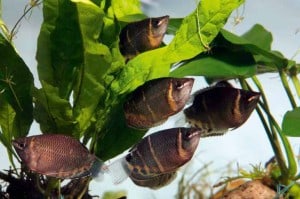
Common name: Chocolate Gourami
Scientific name: Sphaerichthys Osphormenoides, Osphromenus Malayanus, Osphromenus Notatus
Average Adult Fish Size: 1.75 inches / 5 cm
Place of Origin: Malaysia, Sumatra, Borneo
Typical Tank setup: A well planted aquarium with rockwork, driftwood and bogwood. This fish is shy by nature and needs a well decorated aquarium to feel comfortable and limit stress.
Recommended Minimum Aquarium Capacity: 10 gallon / 40 litre
Compatibility: They are a very peaceful fish. Due to their small size they are best kept with other small fish, but they also do well with Discus as they have similar water requirements.
Temperature: 75 – 86 Deg F / 25 – 30 Deg C
Water chemistry: pH 4.0 – 7.0
Feeding: They are omnivorous and do well on a varied diet of quality flake foods, small pellets, brine shrimp (frozen or live), daphnia, brown worms, and blood worms. Live or frozen foods are required to get the Chocolate Gourami into breeding condition.
Sexing: Male Chocolate Gouramis are generally larger overall, and have larger more developed fins than females. The dorsal fins of males are more pointed, and their anal and caudal fins have a more defined yellow edge than females do. Males also tend to exhibit more reddish-brown coloration.
The throat of the male is straighter, while females have a more rounded throat and head, presumably to facilitate mouth brooding. Females will sometimes develop a black spot on the caudal fin.
Breeding: Breeding should only be attempted in a species tank, never in a community tank. Owners should be aware that breeding is difficult, and water conditions must be carefully adhered to. Always condition the breeder pair with high quality foods, particularly the female, as she will not eat for two weeks while holding the eggs.
The Chocolate Gourami is a mouth brooder, but on rare occasions will create a bubble nest. Spawning begins with the female laying a small quantity of eggs on the tank bottom. The male fertilizes the eggs, followed by the female collecting them in her mouth. Males will sometimes assist with this process by picking up fertilized eggs and spitting them towards the female.
Once the eggs are collected, the female will incubate them in her mouth for up to two weeks, while the male protects her from predators. After the fry are fully formed, the female will spit them out. Newly released fry should be fed frequently on Cyclops, Rotifers, and freshly hatched brine shrimp. Ideally the fry should be reared in a separate tank to ensure optimum conditions. However, if the breeding tank is well prepared, with plenty of cover for the fry, they can be reared there.
It is important to note, that the fry are slow-growing and require frequent small water changes. Some breeders will use plastic wrap around open spaces at the top of the tank to ensure that humidity is high above the water surface. As in most Gouramis species, it is believed that the lack of warm humid air can result in failure of the labyrinth organ to develop properly. Daily small water changes are a must. Water quality must be strictly maintained.
Additional Information: This shy and peaceful fish is worth any extra effort needed to successfully keep them. Its common name refers to the dark chocolate brown color of this Gourami, which can vary slightly from reddish-brown to greenish-brown. Frequent partial water changes are needed to successfully maintain this fish. They do not tolerate nitrates well at all. A tight fitting lid is a must to maintain air temperature the same as the water temperature.


Related Posts
Croaking Gourami – Trichopsis vittatus
Benthochromis Tricoti
Large-eyed Mouthbrooder – Callochromis Macrops